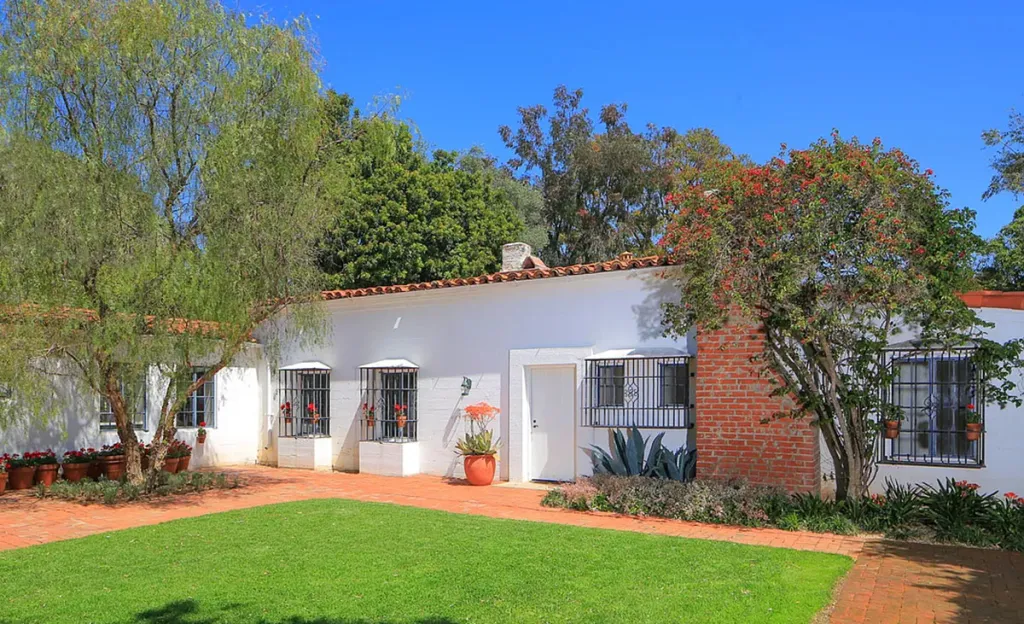การรื้อถอนบ้านพักอันทรงคุณค่าทางประวัติศาสตร์ กำลังกลายเป็นแนวโน้มที่น่าวิตกในลอสแอนเจลิส ส่งผลให้สูญเสียทั้งคุณค่าทางสถาปัตยกรรม และความสำคัญทางวัฒนธรรม กรณีตัวอย่างที่เป็นที่สนใจในช่วงที่ผ่านมาคือ “บ้านซิมเมอร์แมน” ในย่านเบรนท์วูด ออกแบบโดย Craig Ellwood สถาปนิกแนวโมเดิร์น สร้างขึ้นในช่วงทศวรรษ 1950s Chris Pratt นักแสดงฮอลลีวู้ด และ Katherine Schwarzenegger นักเขียน ได้ซื้อและรื้อถอนบ้านพักหลังนี้ เพื่อสร้างคฤหาสน์หลังใหม่ สร้างความไม่พอใจให้กับกลุ่มอนุรักษ์สถานที่ทางประวัติศาสตร์
อีกกรณีที่สำคัญคือ Hacienda ที่สร้างขึ้นในช่วงทศวรรษ 1920s ตั้งอยู่ที่ 12305 Fifth Helena Drive ในย่านเบรนท์วูด ซึ่งเป็นบ้านหลังเดียวที่ Marilyn Monroe เคยเป็นเจ้าของ และเป็นสถานที่ที่เธอเสียชีวิตในปี 1962 โดย Brinah Milstein ทายาทนักธุรกิจด้านอสังหาริมทรัพย์ และ Roy Bank สามี ได้ซื้อบ้านพักหลังนี้ด้วยเงินสดมูลค่า 8.4 ล้านดอลลาร์ ซึ่งทั้งคู่ยังเป็นเจ้าของคฤหาสน์ข้างเคียงอีกด้วย แผนการรื้อถอนบ้านพักอดีตที่อยู่อาศัยของ Monroe เพื่อสร้างพื้นที่ขนาดใหญ่ จุดกระแสต่อต้านอย่างรุนแรง
กลุ่มอนุรักษ์สถานที่ทางประวัติศาสตร์ได้รับชัยชนะเบื้องต้นในเดือนมกราคม เมื่อสภาเมืองลอสแอนเจลิสลงมติเป็นเอกฉันท์ ให้พิจารณาขึ้นทะเบียนบ้านพักหลังนี้เป็นอนุสรณ์สถานทางประวัติศาสตร์ ส่งผลให้กรมโยธาธิการเพิกถอนใบอนุญาตรื้อถอน อย่างไรก็ตาม Milstein และ Bank ได้ยื่นฟ้องร้องเพื่อยืนยันสิทธิ์ในการรื้อถอนบ้านพักหลังนี้
ฝ่ายโจทก์อ้างว่า เจ้าหน้าที่เมืองดำเนินการโดยมิชอบด้วยรัฐธรรมนูญ ในการพยายามขึ้นทะเบียนบ้านพักหลังนี้เป็นแลนด์มาร์ค ทั้งยังกล่าวหาว่าเจ้าหน้าที่ดำเนินการลับหลัง เพื่ออนุรักษ์บ้านพักหลังนี้ ซึ่งฝ่ายโจทก์เถียงว่า ไม่ตรงตามเกณฑ์ของสถานที่ทางประวัติศาสตร์
คำฟ้องอ้างว่า ตัวบ้านพักมีการปรับเปลี่ยนอย่างมาก นับตั้งแต่ Monroe เสียชีวิต รวมถึงการขออนุญาติปรับปรุงบ้านพักมากกว่า 12 ครั้ง ตลอด 60 ปีที่ผ่านมา ฝ่ายโจทก์แย้งว่า ไม่มีหลักฐานทางกายภาพหลงเหลืออยู่ ที่แสดงว่า Monroe เคยอาศัยอยู่ที่นี่ โดยอ้างถึงเฟอร์นิเจอร์ สี หรือพรม ที่เป็นของเดิม อีกทั้งยังอ้างว่า บ้านพักหลังนี้ดึงดูดความสนใจจากแฟนๆ และรถทัวร์นำเที่ยว จนก่อความรำคาญให้กับเพื่อนบ้าน
แม้จะมีการกล่าวอ้างเหล่านี้ แต่บ้านสไตล์บังกะโลหลังเล็ก ขนาด 2,600 ตารางฟุต ก็ยังคงมีคุณค่าทางประวัติศาสตร์อย่างมาก เนื่องจากความสัมพันธ์ของ Monroe กับบ้านพักหลังนี้กลายเป็นที่รู้จักไปทั่วโลก ในฐานะที่เป็นสถานที่ที่ Monroe เสียชีวิตจากการใช้ยาเกินขนาด ขณะอายุเพียง 36 ปี Monroe ยังติดป้ายเหนือประตูหน้าบ้าน ระบุข้อความว่า “Cursom Perificio” ซึ่งแปลว่า “การเดินทางของฉันสิ้นสุดลงที่นี่” ยิ่งตอกย้ำความสำคัญของบ้านพักหลังนี้ต่อตัวเธอ ในขณะที่ภายในบ้านได้รับการปรับปรุงให้ทันสมัย แต่ยังคงมีคุณสมบัติเดิมหลายอย่าง เช่น หน้าต่างบานเปิด พื้นกระเบื้องดินเผา และโถงเพดานที่มีโครงสร้างเป็นไม้ ซึ่งทั้งหมดนี้ช่วยอนุรักษ์เอกลักษณ์ทางประวัติศาสตร์เอาไว้ ชะตากรรมของบ้านพักเก่าแก่ของ Marilyn Monroe ขณะนี้แขวนอยู่บนเส้นด้าย ท่ามกลางการต่อสู้ทางกฎหมายระหว่างฝ่ายอนุรักษ์สถานที่สำคัญ และสิทธิ์ของเจ้าของทรัพย์สิน
จากบทความโดย Wendy Bowman

In Los Angeles, the demolition of historic homes has become a troubling trend, resulting in the loss of architecturally and culturally significant properties. One recent high-profile case involves the “Zimmerman House” in Brentwood, designed by the modernist architect Craig Ellwood in the 1950s. Hollywood actor Chris Pratt and author Katherine Schwarzenegger purchased and subsequently demolished this house to build a new mansion, sparking outrage among preservationists.
Another significant case concerns the storied 1920s hacienda at 12305 Fifth Helena Drive in Brentwood, the only home ever owned by Marilyn Monroe and the site of her death in 1962. This property was acquired in an $8.4 million, all-cash deal by real estate heiress Brinah Milstein and her husband Roy Bank, who also own the adjacent mansion. Their plan to demolish Monroe’s former residence to create a larger compound ignited considerable backlash.
Preservationists scored a temporary victory in January when the L.A. city council voted unanimously to consider the house for historic preservation, leading the building department to revoke the demolition permit. However, Milstein and Bank have since filed a lawsuit asserting their right to demolish the home. They claim city officials acted unconstitutionally in attempting to designate the house as a landmark and accuse them of behind-the-scenes efforts to preserve a house that they argue does not meet the criteria for historic status.
The lawsuit contends that the house has undergone significant alterations since Monroe’s death, including more than a dozen remodeling permits over the past six decades. The plaintiffs argue that no physical evidence remains that Monroe ever lived there, noting the absence of original furniture, paint, or carpets. They also assert that the home attracts unwanted attention from fans and tour buses, creating a nuisance in the neighborhood.
Despite these claims, the modest 2,600-square-foot bungalow holds considerable historical significance due to its association with Monroe. The property became internationally famous as the location of Monroe’s apparent overdose at age 36. Monroe had placed a plaque above the front door reading “Cursom Perificio,” which translates to “My Journey Ends Here,” highlighting the personal importance of the home to her.
While the home’s interiors have been modernized, many original features remain, such as casement windows, terracotta tile floors, and wood-beamed ceilings, preserving its historic character. The fate of Monroe’s former residence now hangs in the balance as the legal battle between preservation efforts and property rights continues.
From the article by Wendy Bowman








